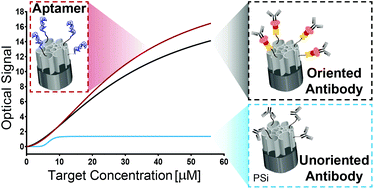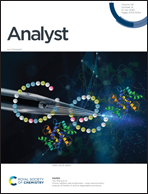Aptamers vs. antibodies as capture probes in optical porous silicon biosensors†
Abstract
Over the past decade aptamers have emerged as a promising class of bioreceptors for biosensing applications with significant advantages over conventional antibodies. However, experimental studies comparing aptasensors and immunosensors, under equivalent conditions, are limited and the results are inconclusive, in terms of benefits and limitations of each bioreceptor type. In the present work, the performance of aptamer and antibody bioreceptors for the detection of a his-tagged protein, used as a model target, is compared. The bioreceptors are immobilized onto a nanostructured porous silicon (PSi) thin film, used as the optical transducer, and the target protein is detected in a real-time and label-free format by reflective interferometric Fourier transform spectroscopy. For the antibodies, random-oriented immobilization onto the PSi nanostructure results in a poor biosensing performance. Contrary, Fc-oriented immobilization of the antibodies shows a similar biosensing performance to that exhibited by the aptamer-based biosensor, in terms of binding rate, dynamic detection range, limit of detection and selectivity. The aptasensor outperforms in terms of its reusability and storability, while the immunosensor could not be regenerated for subsequent experiments.



 Please wait while we load your content...
Please wait while we load your content...